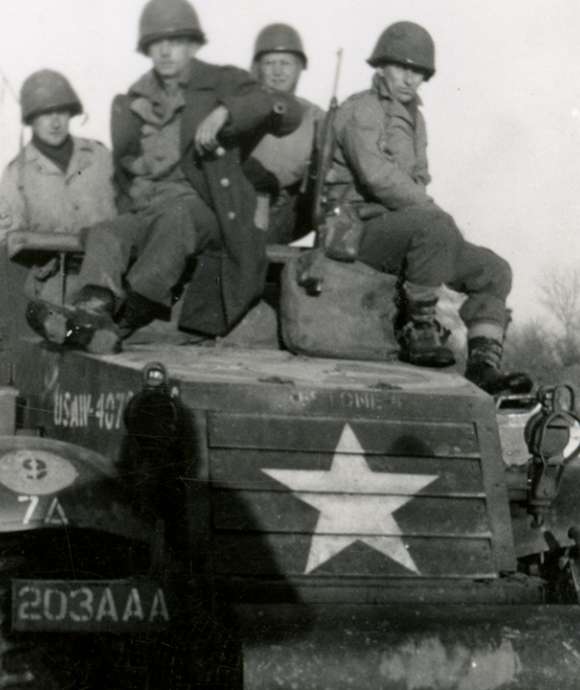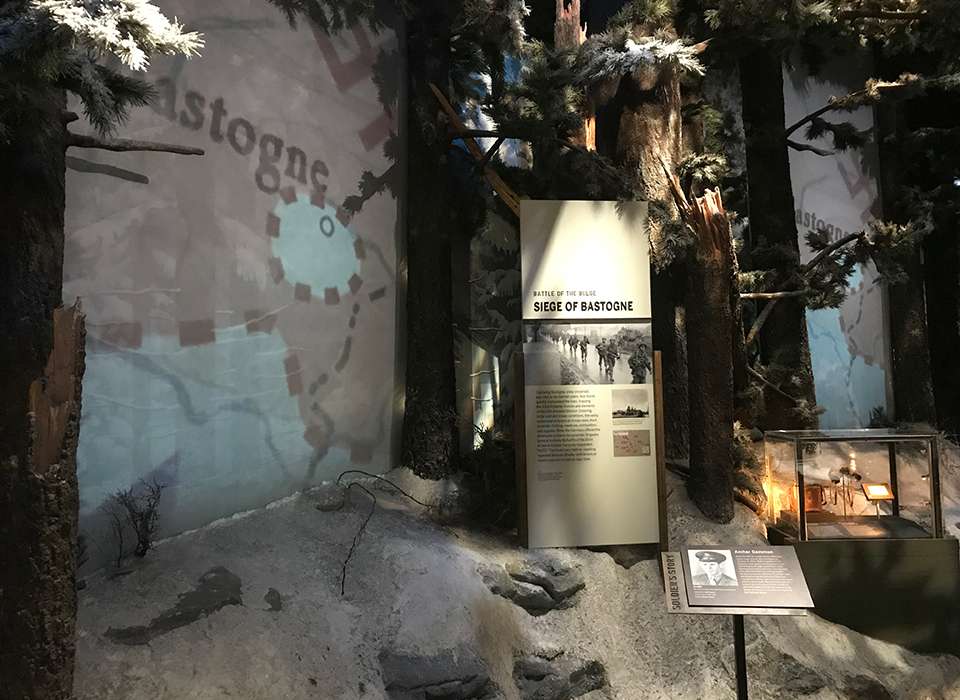This winter also marks the fifth anniversary of the opening of the Duchessois Family Road to Berlin galleries at The National World War II Museum, where many hundreds of thousands of visitors pass through our signature Battle of the Bulge gallery to learn the story of this immense fight in depth. From the museum’s oral history collection there, visitors learn the story of Lyle Bouch and his men of the 394th Infantry Regiment, who were overrun at Lanzareth Ridge when the Germans attacked on December 16, 1944, and heroically stalled the attack for eight crucial hours although they were vastly outnumbered. B.O. Wilkins of the 99th Infantry Regiment also describes his experience being taken as a Prisoner of War in the forest during the battle. Ted Paluch of the 285th Field Artillery Observation Battalion recounts his experience as one of only 43 survivors among over 120 men from the German massacre at Malmedy, Belgium, the following day. Sergeant Frances Currey tells his story of the actions he took to save five fellow soldiers at Malmedy just days later on December 21, 1944, and which earned him the Medal of Honor. Besides animated maps, visitors can interact with digitized artifacts including a Sherman Tank and a German STG-44 assault rifle.
Visitors learn from personal story panels in the gallery about the heroism of Sergeant Jose Lopez of the 2nd Infantry Division, credited with single-handedly holding off German tanks, artillery and infantry when the American left flank collapsed in battle on December 17, 1944, as well as Staff Sergeant Archer Gammons of the 9th Armoured Infantry Battalion, killed in action fighting against a Tiger Tank after successful assaults on German machine guns on January 11, 1945. Both received the Medal of Honor. Visitors can also learn the African American 761st Tank Battalion’s role in relieving the siege of Bastogne, or about Private Kurt Vonnegut, who was taken as a Prisoner of War early in the battle and then imprisoned in Dresden during the Allied bombing of the city in February 1945, experiences which lead to his classic postwar novel Slaughterhouse Five.
Unforgettable artifacts are featured in the gallery. A Nazi flag with signatures from some members of the 101st Airborne Division, who became known as the “Battered Bastards of Bastogne” after holding out in the city after being overrun by the Germans, can be seen. A glove worn by Major General Troy Middleton, who at 480 days spent more time in combat than any other American General, and who decided that Bastogne had to be held, is on display. The Prayer Card issued to the General George Patton’s Third Army at Christmas 1944 can be viewed in a display case. An Opel Sedan, a civilian vehicle used by the Germans as an officer’s car, can be viewed nestled in the interactive environment of the freezing forest in the Ardennes. Visitors can take in the drama of the battle by watching video depicting the stages of the battle upon three screens placed strategically throughout the gallery’s snowy forest, featuring archival footage, photographs, animated maps, and the explosive sounds of battle in a truly unforgettable immersive experience.
Finally, The National World War II Museum not only preserves the history of the Battle of the Bulge in the museum, but regularly organizes tours of the most important battle sights in Belgium and Luxembourg. The 75th anniversary tour is taking place in December 2019, and features veterans of the battle—an unsurpassed educational opportunity and experience which the museum is proud to provide in honor of this iconic history.

The Battle of the Bulge
The US Army's greatest battle to deny Adolf Hitler's last chance for victory
Keith Huxen
Keith is the former Senior Director of Research and History in the Institute for the Study of War and Democracy at The National WWII Museum.
Cite this article:
MLA Citation:
APA Citation:
Chicago Style Citation:





![Max Fuchs, New York City cantor, sings as Rabbi Sydney [sic] Lefkowitz, Richmond, VA, conducts the first Jewish services from Germany.](/sites/default/files/styles/max_650x650/public/2025-10/image1.jpg)



